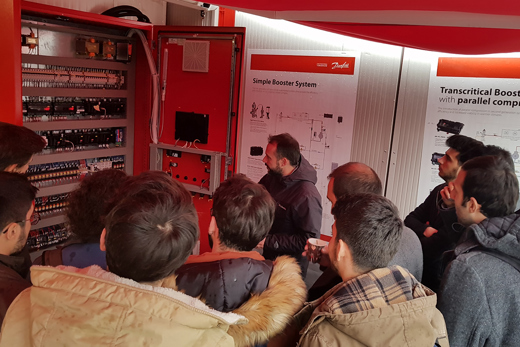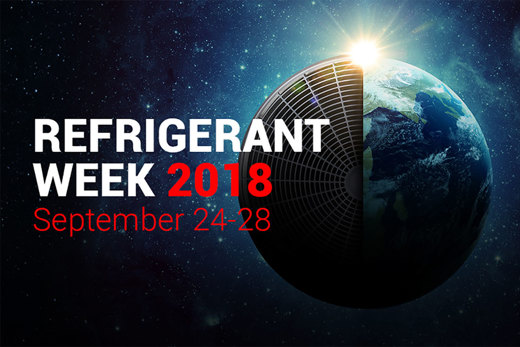The consequences of climate change are becoming increasingly clear as floods, droughts, and other forms of extreme weather are making it an important issue on the global agenda. All over the world, authorities are acting on this knowledge, taking steps to counteract climate change by imposing regulations that affect many industries, including refrigeration and air conditioning. In the EU, for example, the F-gas regulation will result in a gradual phase-down of HFC refrigerants by 2030 through quota systems and sectorial bans on high-GWP refrigerants. Manufacturers and other industry professionals are following suit.
"Even though different countries have different time frames, changing to more climate-friendly cooling is a global concern," said Laure Durrbach, Marketing Communication Manager for Danfoss Cooling. Danfoss is a front-runner in the effort to mitigate climate change and is actively supporting the transition to more sustainable refrigeration. The company is working to keep people, products, and the planet cool by offering components that make refrigeration more efficient and economical. They accomplish this by using refrigerants such as CO2 and intelligent control solutions that save energy by accurately adjusting system performance to meet current demand.
The reality of climate change needs to be met head-on with knowledge and solutions that mitigate its effects. New technologies developed by Danfoss provide solutions, but also create the need for a higher level of knowledge, and therefore more training and education. Industry professionals understand this and actively seek out resources that give them an overview of what solutions are available as they work to comply with regional, national, and global regulations.

Supporting customers wherever they are
This natural interest in knowledge is a key driver behind the training opportunities offered by Danfoss. “When we talk to wholesalers, OEMs, and key accounts, training is one of their most important requests,” said Orysya Birkkjær, Training Manager at Danfoss. “Our customers are interested in knowing how cooling solutions work. Of course, they need fast delivery times and high quality, but they also need to know how it works, what solutions we have, and if we have any tips and tricks. The whole thing is very customer driven.”
Danfoss has a long history of supporting its customers through comprehensive training that satisfies the need for know-how on multiple levels. Their aim is to support customers in building their capabilities and acquiring new knowledge. Existing and prospective customers must be aware of how to use Danfoss products, understand the features and value they add and know how to install and service them.
But customers have different needs and habits, and Danfoss training, therefore, takes many different forms. The company makes an effort to meet and support its customers across all touchpoints no matter where the customers are. Danfoss training and education efforts, therefore, range from installation videos on YouTube and awareness campaigns on social media channels to hands-on training at Danfoss facilities and mobile training units at the customer’s location. The company offers a collection of digital resources such as software, tools, and webinars. Finally, they work to actively promote a positive climate message through the media and take part in international forums such as the UN.ugh the media and in international fora such as the UN.

Danfoss Learning: free online training
The most popular training offering from Danfoss is the Danfoss Learning portal; an online solution where users can study eLessons around the clock. Over 1,500 courses are available in up to 26 languages — free of charge. Users simply need to register.
Danfoss Learning is used by customers, partners, students, and prospects — anyone in need of reliable information about products, techniques, applications, or industry regulations. Training programs in Danfoss Learning include lessons on refrigeration fundamentals, cold rooms, chillers, and industrial refrigeration, just to name a few. According to Orysya, Danfoss Learning members show a particular interest in topics such as installation and service techniques and tools that support their daily business. They also want to know more about the Danfoss portfolio, seeking out an overview of the solutions available for cold rooms and what Danfoss is doing to adapt to the F-gas regulation, for example.
The availability of free, high-quality information has made Danfoss Learning a resounding success. Over 50,000 people have registered to date; among them the members of a Chinese refrigeration association who migrated to the platform and use it to train on technical issues. “I’m happy and proud that we have 50,000 users, and I think the reason is very simple: We offer content that people can use,” said Orysya. She added that Danfoss is constantly gathering usage metrics and user feedback in order to evaluate and improve the system. “We take comments from our users very seriously,” she said. “Training requests, improvement possibilities, user-generated content, new business opportunities; there are many elements that we gather and respond to while interacting with our users.”
Tailor-made offerings and software tools
While Danfoss Learning is a widespread and popular solution, it is not the only training possibility that Danfoss provides. The company also offers hands-on, face-to-face training at Danfoss facilities or in cooperation with educational institutions such as the Technical College of Jutland in Denmark, TAFE in Australia, and the NCCD in India. Customer groups are also occasionally invited to participate in hands-on training at participating colleges or invited on guided tours of actual refrigeration installations.
For customers who are unable to travel to the nearest Danfoss site, Danfoss conducts hands-on training using mobile training units. Over the past two years, a mobile training unit offering training on CO2 refrigeration solutions has been touring the world, visiting customer and partner sites to increase awareness and demonstrate hands-on knowledge of the solutions Danfoss has to offer. For partners in need of specialized training, Danfoss offers tailored certification programs. “Anyone can sign up for free training through Danfoss Learning, for example on using CO2 as a refrigerant,” explained Orysya. “But partner companies with big projects coming up might want to educate their staff on more specialized or specific topics, both on a commercial and technical level. For such partners, we can tailor specific programs where students go through a combination of 30 or 40 hours of customized online programs, face-to-face training, or webinars. When they complete the training, they receive a certificate of completion signed by Danfoss management that is valid for one year.”
Turkish installers follow a hands-on training course in the Danfoss mobile training unit. Meeting customers where they are is a cornerstone of the Danfoss Cooling training philosophy.
In addition to providing know-how through the channels above, Danfoss also offers several software tools that are free of charge. The HVACR Service Tool, for example, is a troubleshooting solution designed to save contractors and service technicians valuable time in the field digitized component notes and image recognition. The Coolselector®2 software helps users specify refrigeration solutions based on parameters such as cooling capacity, refrigerant, evaporation and condensation temperature. Both tools offer unbiased, trustworthy calculations and knowledge to HVACR professionals.

Refrigerant Week: more than a webinar
Refrigerants are a key industry topic at the moment and are the subject of a lot of discussions. Not only are they indispensable in the daily operation of cooling systems everywhere, but they are a key concern when it comes to the transition to lower GWP refrigerants. To raise awareness of this urgent issue, Danfoss has hosted a Refrigerant Week in September over the past two years. The global event has included free webinars on topics such as the future of sustainable cooling, global trends on refrigerants and regulations, how to handle flammable refrigerants, reducing refrigerant charges, and CO2 in industrial systems. The Refrigerant Week, however, is much more than just a collection of webinars. “We will publish a number of articles related to the topics we will be working on, and there will be infographics, videos, and selection tools in addition to the webinars,” explains Laure, project leader for Refrigerant Week. “We have a vision of what is happening, of the viability of refrigerants, of regulations, and of technical progress. That’s why we wanted an event communicating this vision and discussing it with a wide scope of stakeholders and experts.”
The event was designed to raise awareness and stimulate discussion about the refrigerant transition and was executed in cooperation with industry professionals, policymakers, and other external experts. To date, hundreds of companies from 50 countries and speaking 11 different languages participated. According to a post-event survey, 80% of participants found the event helpful in their daily jobs. Both Refrigerant Weeks coincided with Climate Week in New York City, increasing awareness of the refrigerant issue and creating synergies between businesses and policymakers working towards the same goal.
Danfoss is a Delivery Partner of Sustainable Energy for All (SEforALL), an initiative designed to accelerate progress on the United Nations Sustainable Development Goal (SDG) 7: ensuring universal access to modern energy services, improving efficiency, and increasing the use of renewable sources. The Refrigerant Week is a natural part of this work and is also a natural part of Danfoss Cooling’s effort to educate its customers, partners, users, and other stakeholders.
While the annual Refrigerant Week puts a sharp, timely emphasis on the discussion about refrigerants, industry professionals and customers can find refrigerant resources and tools year round at the Danfoss Refrigerant Transition Center.
Just add know-how
The challenges of tomorrow cannot be solved by relying on yesterday’s technologies. New solutions need to be found, and
knowledge of those solutions needs to be widely available. This is why Danfoss has placed such a high priority on training and education – from tips and tricks on how to optimize CO2 systems to analyses of how the transition away from HFCs can contribute to a better climate worldwide. Danfoss offers training that helps all stakeholders in the refrigeration business make a contribution to a better climate and improved living conditions for everyone on the planet. The solutions are available; you just need to add a little know-how.
For more information, visit cooling.danfoss.com
